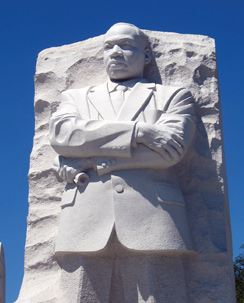
Reaching for the Dream
Abutting the Potomac River near the Lincoln Memorial sits the only monument on the Mall in Washington, DC honoring a person of color. The Martin Luther King, Jr. Memorial celebrates peace and unity of all peoples, and visitors see two large pieces of white granite called the “Mountain of Despair” to reach the “Stone of Hope,” out of which appears a carving of a standing MLK; both phrases were taken from King’s famous “I Have a Dream” speech where he said “out of the mountain of despair, a stone of hope.”
Harry Johnson, Sr., President and CEO of the MLK National Memorial Project Foundation, said the memorial is meant to inspire everyone, not just one particular group: “This is not just about Dr. King or the civil rights moment, but the about the message, his legacy, which is justice, hope, democracy and love.”
Those four themes represent his legacy, adds Johnson, a former president of the same fraternity Dr. King belonged to as a student, Alphi Phi Alpha. “Justice” to ensure that everyone’s rights are protected under law; “Hope” because without it the civil rights movement would not have survived; “Democracy” to ensure that everyone participate in government even if they are a outnumbered; and “Love” as the “fuel” of non-violent change.
“Dr. King’s message was about all people, without regard to race or gender. This memorial is for everybody, not just the African American community,” says Johnson.
From the very beginning, Latinos were involved in the U.S. civil rights movement, and the late labor leader César Chávez once told a gathering of activists in 1990 that Dr. King represented what can be accomplished through collaboration among groups: “He realized that the only real wealth comes from helping others. I challenge you to carry on his work by volunteering to work for a just cause you believe in. If we fail to learn that each and every person can make a difference, then we will have betrayed Dr. King’s life’s work. The Reverend King had more than just a dream. He had the love and the faith to act.”
Dr. King himself sent a telegram to a then-fasting Chávez as a sign of solidarity: “As brothers in the fight for equality, I extend the hand of fellowship and good will and wish continuing success to you and your members. ...You and your valiant fellow workers have demonstrated your commitment to righting grievous wrongs forced upon exploited people. We are together with you in spirit and in determination that our dreams for a better tomorrow will be realized.”
NCLR CEO Janet Murguía calls herself a “child of Dr. King’s hope” and considers his work transcendent. “Dr. King’s dream was an inclusive dream and spoke to more than one community. It was universal and transcendent,” she says. “Dr. King’s telegram was a call to action. And his words are just as relevant today as we continue to fight to make the promises of democracy real for all Americans. It is why we are working so hard to make sure all of us have a voice, “Because nothing is stronger than our commitment to civil rights and human dignity. Nothing is stronger than our commitment to full and equal political participation. Nothing is stronger than our commitment to increased opportunity for all.”
The memorial was 15 years in the making after a Congressional Joint Resolution in 1996 sparked the process. Congress donated the four acres for the site, but it was up to the foundation to raise the bulk of the $120 million needed. “In the spirit of Dr. King, this was a collaboration of many groups and organizations,” Johnson said. “Dr. King understood that the strength of our nation is in diversity.”
Murguía, who in 2008 was the first Hispanic keynote speaker at the annual Martin Luther King Jr. Unity Breakfast in Birmingham, Alabama, adds, “This country cannot reach its full potential, unless all of its people---regardless of race, ethnicity, gender, religion, or sexual orientation---have a fair chance at the American Dream.”
Patricia Guadalupe
